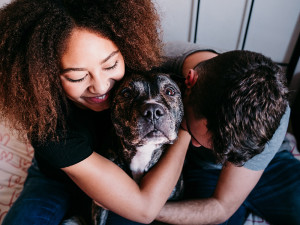Chemistry Between People and Dogs Is Real (It’s Science)
How the “love hormone” oxytocin connects us with our pups.
Oxytocin — known as the “love hormone” — is that seemingly magical chemical we usually associate with baby-parent bonding and post-coital snuggling. Turns out that oxytocin also plays a major role in humans’ relationships with dogs, too. Much of the early research on oxytocin is focused on people, but research shows that it also impacts our connections with pups.
How does oxytocin work?
Let’s start with human bonding: Oxytocin levels have been shown to be higher in people who have been in romantic relationships for three months than in those who are single. And, it turns out, couples with higher oxytocin levels at three months are more likely to be together six months later.
Save on the litter with color-changing tech that helps you better care for your cat.
In another type of emotional relationship, mothers who gaze at their babies have higher levels of oxytocin. Mothers with higher oxytocin levels engage in more mothering behavior, which raises oxytocin levels in their babies, which leads babies to be more attached and attentive to their mothers, creating a never-ending positive feedback loop. Oxytocin levels also increase in mothers and babies who touch frequently and decrease when they’re prevented from touching.
In a parallel phenomenon, petting causes humans and dogs to experience an increase in oxytocin. Because dogs affect us and our oxytocin levels much the same as human babies do, the bond we have with our dogs can feel like the bond between mothers and children. The mechanism behind the connection is the same.
Looking at dogs and oxytocin
A 2015 studyopens in new tab was the first to demonstrate oxytocin’s cross species effects. In the study (Oxytocin-gaze Positive Loop and the Coevolution of Human-dog Bonds), dog-human pairs were observed interacting during a 30-minute period. The dogs who gazed at their guardians longer displayed higher levels of oxytocin than those in pairs who did not gaze at one another for as long. A caveat: Like many other areas of canine behavior, eye contact is complex, nuanced, and context-dependent. While gazing into the eyes of a dog you love and who loves you can create a tender moment, staring into the eyes of an unknown or unfriendly dog can be perceived by the dog as threatening and scary.
Biologists were excited to find underlying physiological mechanisms common to the formation of both romantic and parental social bonds. Dog lovers were enthralled by the evidence that we love our dogs like we love people, scientifically speaking. It’s possible that the process of domestication was facilitated by canines co-opting this human social-bonding process.
Gender differences in the effects of oxytocin
In the same study, researchers performed another experiment to further explore the role of oxytocin in dog-human bonding. After administering the hormone to dogs via the nose, they observed that female dogs given oxytocin gazed at their guardians for longer periods than did female dogs given saline as a control (it didn’t affect male dogs the same way). Even though people were not given oxytocin, human oxytocin levels also increased after interacting with female dogs who had received it. Researchers are not sure why the behavior of female — but not male — dogs was affected.
Caregiving models
In addition to facilitating the formation of strong bonds between mothers and babies as well as people and dogs, oxytocin is critical for the development of our caregiving behavior toward both newborns and dogs. If an individual is cute, we feel love, and if we feel love, we want to take care of what we love. Infantile characteristics seen in many young mammals — proportionally large head, big and wide-spaced eyes, chubby cheeks, small mouth and nose — activate our instinct to be caring and protective because they trigger a release of oxytocin.
Oxytocin inspires mothers to respond to babies
A lot of the research about caregiving and oxytocin was done with mice, but the same pattern occurs in many mammals. Baby mice cry when they are separated from their mothers, who respond to those vocalizations by going to them. Mothers even respond to the calls of unrelated baby mice. (Female mice without babies rarely respond.)
Mouse mothers must learn to respond to those cries, and oxytocin is necessary for that education to take place. Oxytocin changes their brains, and only after those changes do they react to their offsprings’ vocalizations by attending to them. The changes occur in the left auditory cortex, a region of the brain that scientists recently discovered has neurons that produce oxytocin; it also has a large number of oxytocin receptors.
To test whether this area of the brain is important for maternal care, scientists used a drug to block its activity, and found that females who received the drug ceased to respond to their crying babies. They also found that inexperienced females who had been unresponsive became responsive after being injected with oxytocin.
Tuning in to social signals
In addition to playing a role in our attachment to each other, oxytocin can affect dogs’ responses to our social cues. In a 2015 studyopens in new tab (Oxytocin Enhances the Appropriate Use of Human Social Cues by the Domestic Dog in an Object Choice Task), dogs were divided into two groups; one group was given an injection of oxytocin, the other, of saline solution. The oxytocin group was more responsive to social cues by humans indicating the location of food than those in the control group who had received saline. Dogs were more successful at following human cues to find the food when they had been treated with oxytocin; this was true for two types of human signaling: gazing at and pointing to the location of the hidden food.
The study’s most exciting finding was that oxytocin makes dogs more receptive to social signals. Since oxytocin is also known to make memories of negative social interactions more intense as well, it is fair to say that this chemical may allow individuals of a variety of species to focus their attention on social information and enhance their ability to understand it at a deeper level. Though oxytocin is well known to promote positive emotional states, this research suggests that it can have a negative effect in some circumstances.
Differences between breeds
Many other studies have explored the effects of oxytocin on dogs. In one published in 2016opens in new tab, Differential Effects of Oxytocin on Social Sensitivity in Two Distinct Breeds of Dogs, oxytocin was given to Border Collies and Siberian Huskies to test its influence on their social responsiveness. The former are as famous for being cooperative workers as the latter are for working on their own. The results? Border Collies had a stronger response to receiving oxytocin than the Siberian Huskies, as measured by their behavior after treatment. This seems to mean that independent dogs can’t be converted to the most affiliative of dogs simply by administering oxytocin. Thanks to differences in the ways they react to it physiologically, not all dogs (or all breeds) experience the same effect.
Oxytocin makes dogs friendlier
A 2017 studyopens in new tab (Oxytocin and Opioid Receptor Gene Polymorphisms Associated with Greeting Behavior in Dogs) found that variations in the receptor genes for oxytocin were related to dogs’ willingness to greet unfamiliar people. In German Shepherds, the form of the gene that an individual dog possessed was an excellent predictor of how friendly that dog was toward people. A similar trend — though not conclusive — occurred in Border Collies. (The pattern did not hold in Siberian Huskies.)
Differences between assistance dogs and pets
In another 2017 study opens in new tab that explored the role of oxytocin on social behavior (Endogenous Oxytocin, Vasopressin, and Aggression in Domestic Dogs), researchers compared its levels in dogs bred to work as assistance dogs to its levels in pet dogs. The assistance dogs were from a population that has been bred for more than 40 years for traits such as friendliness, calm temperaments and the lack of aggressive behavior. At the physiological level, these dogs had higher oxytocin levels when compared to pet dogs, suggesting that the selective breeding of these dogs may have acted on their oxytocin levels, and that changes in the levels of the hormone may also influence the likelihood of aggressive behavior.
The science is clear
That dogs have such a profound influence on our lives is not news to anybody, but their effects on our physiology continue to make headlines. Petting our dogs can increase our oxytocin levels (and theirs!); even thinking about our dogs can make them rise. Having our dogs on our mind when life gets rough may be a good idea because oxytocin can reduce stress, increase pain tolerance and enhance well-being.
With its reputation as the “feel-good hormone,” it’s no surprise that oxytocin figures heavily into our relationship with dogs. We’ve learned much about its effects on both species, and new research will surely reveal even more about its relevance to the bond we share. For now, we can summarize what’s known by saying that if you’re convinced that the chemistry between you and your dog is real, science definitely has your back.










